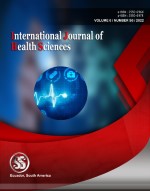Factors affecting the oral health behavior of Indian married women
It’s lifestyle of something else? (a questionnaire based original research study)
Keywords:
questionnaire, oral hygiene, periodontics, oral hygiene indexAbstract
With an objective to better understand differences in oral health related behavior and practices of working and non working, this study was conducted. Duration of the study was three months, from August 2021 to October 2021 and it was conducted in Department of Periodontics, Mansovar Dental College and Research Center, Bhopal (M.P.), India. A questionnaire based survey was conducted amongst 300 married female participants aged 18 years or more (111 working women and 189 non-working women). The samples were heterogeneous group from different occupation and economic status. None of the participants in the present study was found to have good oral hygiene and more than 50.0% of the patients were having poor oral hygiene. It is an observation which needs attention. It was hence concluded that the oral health related behavior of the working and non-working married woman differ significantly.
Downloads
References
Attamimi, H. R. ., Lestari, Y. ., Situmorang, B. . H. L. ., Antari, G. Y. ., & Nugrawati, N. . (2020). Application of habituation method in germas interventionsin: the pandemic time COVID-19 . International Journal of Health & Medical Sciences, 3(1), 98-104. https://doi.org/10.31295/ijhms.v3n1.175
Avasthi A, Veeresha KL, Bilal D. Oral health status of middle-aged (45–55 Years) rural women: A cross-sectional study from North India. Contemp Clin Dent 2019;10:595-9.
Demetriou C. Self-Report Questionnaires. The Encyclopedia of Clinical Psychology, First Edition. Edited by Robin L. Cautin and Scott O. Lilienfeld. © 2015 John Wiley & Sons, Inc. Published 2015 by John Wiley & Sons, Inc. DOI: 10.1002/9781118625392.wbecp507.
Dholakia PM & Morwitz VG. How surveys influence customer. Harvard Business Review 2002. https://hbr.org/2002/05/how-surveys-influence-customers
Gouda J, Prusty RK. Overweight and obesity among women by economic stratum in urban India. J Health Popul Nutr. 2014;32(1):79-88.
Jackson EM. The role of exercise in stress management. ACSM’s Health & Fitness Journal 2013;17(3):14-19.
Joglekar A & Kundle S. A Study of Inclination towards Convenience Food among Working and Non-Working Women. Online International Interdisciplinary Research Journal 2013;3(5):194-203.
Murakami M, Ohkubo T & Hashimoto H. Socioeconomic Inequalities in Oral Health among Unmarried and Married Women: Evidence from a Population-Based Study in Japan. J Epidemiol 2018;28(8):341-346.
Nagarjuna P, Reddy VC, Sudhir KM, Kumar RK, Gomasani S. Utilization of dental health-care services and its barriers among the patients visiting community health centers in Nellore District, Andhra Pradesh: A cross-sectional, questionnaire study. J Indian Assoc Public Health Dent 2016;14:451-5.
Oberoi SS, Mohanty V, Mahajan A, Oberoi A. Evaluating awareness regarding oral hygiene practices and exploring gender differences among patients attending for oral prophylaxis. J. Indian Soc Periodontol 2014.18:369-74.
Oracon KC and Kumari R. A Psychological Study on Stress among Working and Non-Working Married Women. The International Journal of Indian Psychology April - June 2019;7(2):357-362.
Panigrahi A, Padhy AP, Panigrahi M. Mental Health Status among Married Working Women Residing in Bhubaneswar City, India: A Psychosocial Survey. BioMed Research International Volume 2014, Article ID 979827, 7 pages.
Priyadarshini V. A comparative study on dietary patterns and nutritional status among working and non-working women of Keonjhar city. Asian J. Home Sci., 2016;11(2):320-326, DOI: 10.15740/HAS/AJHS/11.2/320-326.
Pullishery F, Shenoy Panchmal G, Shenoy R. Parental Attitudes and Tooth Brushing Habits in Preschool Children in Mangalore, Karnataka: A Cross-sectional Study. Int J Clin Pediatr Dent. 2013;6(3):156-160. doi:10.5005/jp-journals-10005-1210.
Rani RU & Bhuvaneshwari K. An Analysis on the Main Factors of Occupational Stress among Indian Women – A Soft Computing Approach. International Journal of Computational Intelligence and Informatics 2014; 4(2):155-162.
Sharma L & Chaudhary D. comparative study of BMI and aggression between working and non working women in Meerut region. Global Journal for Research Analysis 2020;9(9):144-145.
Shukla S, Jaiswal M, Agrahari K & Singh A. A study on stress level among working and nonworking women. International Journal of Home Science 2017; 3(1): 349-357.
Suryasa, I. W., Rodríguez-Gámez, M., & Koldoris, T. (2021). The COVID-19 pandemic. International Journal of Health Sciences, 5(2), vi-ix. https://doi.org/10.53730/ijhs.v5n2.2937
Thapa P, Aryal KK, Mehata S. et al. Oral hygiene practices and their socio-demographic correlates among Nepalese adult: evidence from non communicable diseases risk factors STEPS survey Nepal 2013. BMC Oral Health 16, 105 (2016). https://doi.org/10.1186/s12903-016-0294-9.
Tiwari S & Tripathi S. Study of nutritional status & dietary pattern of working women and non-working women of Jabalpur. Global Journal of Engineering Science and Researches 2018;5(5):62-65.
Torres OV, O'Dell LE. Stress is a principal factor that promotes tobacco use in females. Prog Neuropsychopharmacol Biol Psychiatry. 2016;65:260-268. doi:10.1016/j.pnpbp.2015.04.005.
Vissandjee B, Barlow R & Feaser DW. Utilization of health services among rural women in Gujarat, India. Public Health 1997 May;111(3):135-48.
Wennström A, Ahlqwist M, Stenman U, Björkelund C, Hakeberg M. Trends in tooth loss in relation to socio-economic status among Swedish women, aged 38 and 50 years: repeated cross-sectional surveys 1968-2004. BMC Oral Health 2013;13:63.
Published
How to Cite
Issue
Section
Copyright (c) 2022 International journal of health sciences

This work is licensed under a Creative Commons Attribution-NonCommercial-NoDerivatives 4.0 International License.
Articles published in the International Journal of Health Sciences (IJHS) are available under Creative Commons Attribution Non-Commercial No Derivatives Licence (CC BY-NC-ND 4.0). Authors retain copyright in their work and grant IJHS right of first publication under CC BY-NC-ND 4.0. Users have the right to read, download, copy, distribute, print, search, or link to the full texts of articles in this journal, and to use them for any other lawful purpose.
Articles published in IJHS can be copied, communicated and shared in their published form for non-commercial purposes provided full attribution is given to the author and the journal. Authors are able to enter into separate, additional contractual arrangements for the non-exclusive distribution of the journal's published version of the work (e.g., post it to an institutional repository or publish it in a book), with an acknowledgment of its initial publication in this journal.
This copyright notice applies to articles published in IJHS volumes 4 onwards. Please read about the copyright notices for previous volumes under Journal History.
















